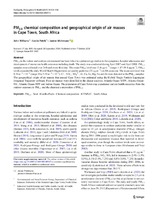| dc.contributor.author | Williams, J | |
| dc.contributor.author | Petrik, L | |
| dc.contributor.author | Wichmann, J | |
| dc.date.accessioned | 2021-05-11T11:26:47Z | |
| dc.date.available | 2021-05-11T11:26:47Z | |
| dc.date.issued | 2021 | |
| dc.identifier.citation | Williams, J. et al. (2021). PM2.5 chemical composition and geographical origin of air masses in Cape Town, South Africa. Air Quality, Atmosphere and Health, 14(3),431-442 | en_US |
| dc.identifier.issn | 1873-9318 | |
| dc.identifier.uri | 10.1007/s11869-020-00947-y | |
| dc.identifier.uri | http://hdl.handle.net/10566/6135 | |
| dc.description.abstract | PM2.5 in the indoor and outdoor environment has been linked in epidemiology studies to the symptoms, hospital admissions and development of numerous health outcomes including death. The study was conducted during April 2017 and April 2018. PM2.5 samples were collected over 24 h and every third day. The mean PM2.5 level was 13.4 μg m−3 (range: 1.17–39.1 μg m−3). PM2.5 levels exceeded the daily World Health Organization air quality guideline (25 μg m−3) on 14 occasions. The mean soot level was 1.38 m−1 × 10−5 (range: 0 to 5.38 m−1 × 10−5). Cl−, NO3−, SO42−, Al, Ca, Fe, Mg, Na and Zn were detected in the PM2.5 samples. | en_US |
| dc.language.iso | en | en_US |
| dc.publisher | Springer Science and Business Media Deutschland GmbH | en_US |
| dc.subject | Chemical composition | en_US |
| dc.subject | Health effects | en_US |
| dc.subject | HYSPLIT | en_US |
| dc.subject | South Africa | en_US |
| dc.subject | Soot | en_US |
| dc.title | PM2.5 chemical composition and geographical origin of air masses in Cape Town, South Africa | en_US |
| dc.type | Article | en_US |

